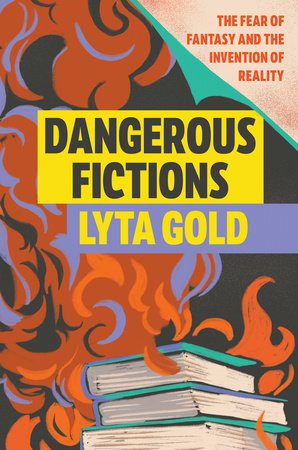Ten years ago, when my twin girls were about seven, conversations about books changed among the parents I knew. Up until then, it had mostly been about our kids learning to read at all. Now they could, and questions shifted into what they were reading. At what age were they old enough for Harry Potter? Should we encourage graphic novels or not? Was it a problem that some girls only seemed to want to read Rainbow Fairies? How many Warriors books are there?! When asked what I was letting my girls read, I mostly laughed it off and said some variation of, “Well, we grew up reading Sweet Valley High and Flowers in the Attic. I think they’ll be okay.” Part of this was an attempt at making light of the way my Boomer parents were too busy worrying about themselves to care what I read, but it also felt related to larger anxieties that I didn’t quite understand. Reading Lyta Gold’s Dangerous Fictions: The Fear of Fantasy and the Invention of Reality (Soft Skull Press, 2024) made it much clearer to me, belatedly, what was going on. The worry over what our children were reading was tied to the question of who they might become and if we could control that outcome.
Dangerous Fictions is an examination of the phenomenon in Western culture whereby anxiety about the negative effects of made-up stories lead to efforts to control access to those stories, especially among vulnerable groups. The author traces the fear of fiction’s potential to lead the virtuous astray from its beginnings in our recorded history, with Plato himself. His call to ban the poets rather than let them ruin the utopian society he envisioned can be understood, Gold argues, as the beginning of the link between Western authoritarianism and the need to keep storytelling in the hands of the powerful. Chapter by chapter, Gold leads us through the various incarnations of this fight. The first novelists were dismissed as writers of silly trash that was ruining the moral character of young women who enjoyed reading their books. Comic books, pulp novels, video games, and superhero movies have all been targeted over the years by moralizing elders concerned that the youth may follow the wrong examples.
Gold asks readers to consider what it means that these anxieties ultimately recur about “other people” and that the vulnerable are often identified as women and children. The efforts to police what ideas the less powerful are exposed to cannot be separated from patriarchal structures that are threatened by free thinking. Throughout the book, Gold makes clear that arguments about possible dangers of reading fiction cannot be separated from concerns about power. They are, therefore, inherently political. This is explored in depth in chapters that recount, for instance, the efforts of the CIA during the mid-twentieth century to fund writers that were producing the “right” kind of books: those that promoted values of individualism, self-reliance, democracy, and above all, capitalism. The idea that we are still very much living in the America that this propaganda created is sobering. It is also, while reading this book, difficult to refute. We are once again living through an age when this fight over the purpose of storytelling, whose stories deserve to be heard, and how freely ideas should circulate is heated. For instance, according to PEN America, 2023 was a banner year for book bans in America schools, with most challenges being mounted against books with LGBTQ+ content or authors of color.
Dangerous Fictions is a rich text, well-researched and full of insights. It is notable that although the work is full of both facts and theories, it never devolves into mere reporting. There is a danger, in such intelligent and challenging texts, that the writing itself can become dry recitation, but Gold’s voice remains engaging throughout. The tone is entertaining, that of a professor who becomes the favorite of students because they know how to make the work relevant and often drily funny. The book can at times veer into the territory of an essay, circling the topic and questioning its own enterprise, allowing the reader to trace the writer’s thought processes in sorting through the questions raised. For instance, at one point Gold contemplates whether it is, in fact, the truth fiction is dangerous. She concludes “Sure. But life is dangerous. The opposite—death, stagnation, stasis—is very boring.”
Perhaps the most compelling section, given the current cultural climate, was the section exploring the particular response to fiction that is characteristic to fascism. Gold is not the first to note this, as she points out in the narrative. Fascists have always concerned themselves with art and take it very seriously. The peculiarity that we are witnessing now in real time, though, is the unsettling way that fascists blur the line between reality and fiction. Gold puts it this way, “. . . you could argue it’s an attempt to turn the whole world into one huge fantasy story, one flat and evil dream.”
The challenge, in attempting to communicate how compelling this book is, looms large. It feels as if I could only tell you how important these ideas are if I tell you everything in it, which would of course defeat the point of writing. My copy of the book is so full of notes and highlights that it has become essentially a commonplace book on its own. I wish I’d had these ideas with me when I was discussing whether Rainbow Fairies were okay to give to my little girls. It may have made it easier to defend my choice to allow only pleasure to guide them in their reading. To reject utility in the face of pressure to choose the “right” books felt . . . well, dangerous. May we all feel freer to follow pleasure, in the name of a less boring life and world.




